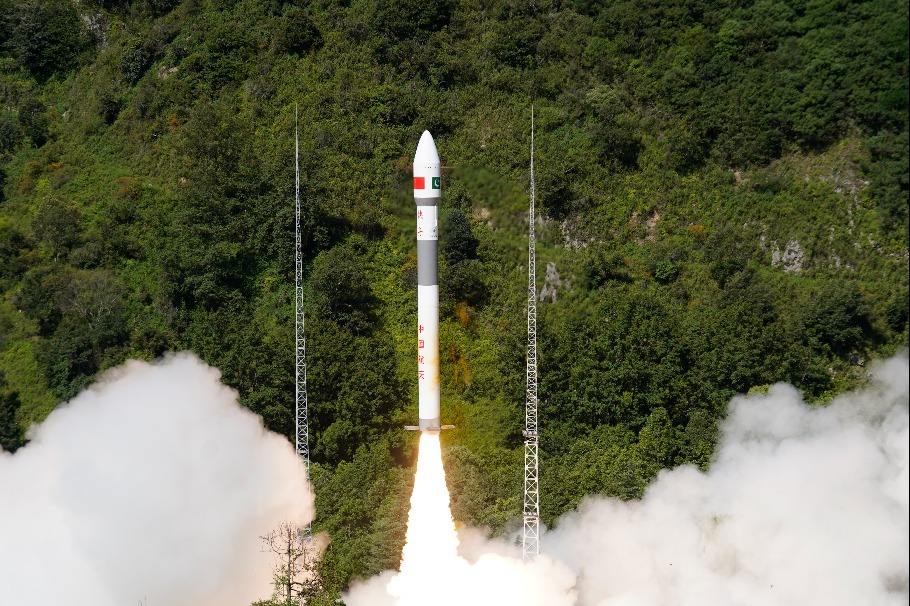Nation tackles electricity demand amid heatwave


China's power sector has implemented a wide range of measures to tackle soaring temperatures and surging electricity demand as a result of this summer's intense heatwave.
High temperatures pose a serious risk to both power equipment and workers. Wang Lei, deputy director of the operation department at the Liujiaxia Hydropower Station in Gansu province, said the most immediate impact is increased thermal stress on power transmission and transformation systems, which jeopardizes their operational safety and reliability.
Wang added that heat waves also exacerbate equipment failures, requiring faster response times from maintenance crews.
"Yet the harsh working conditions during heat waves impair human efficiency, creating a dual challenge of strained infrastructure and reduced workforce effectiveness," he said.
In addition to equipment stress, electricity demand surges during high temperatures — particularly from air conditioning use. Persistent high temperatures have also worsened drought conditions, pushing up demand for water and electricity for crop irrigation and significantly increasing the overall power load, Wang said.
According to data from the National Energy Administration, the country's maximum power load reached 1.465 billion kilowatts on July 4 — up about 200 million kW from the end of June and nearly 150 million kW higher than the same period last year, setting a new record.
To meet this rising demand, the power industry is using a combination of advanced technology and expanded generation to secure energy supplies.
"At Liujiaxia Hydropower Station, smart patrol and inspection systems use AI to monitor the operational trends of equipment. If any fault signals are detected, immediate intervention can be carried out to minimize system failures," Wang said.
The AI system also helps optimize power grid interconnection to improve load distribution and reduce system risks. By running large-scale simulations and predictive modeling, it can signal the ideal timing for switching between grid configurations to enhance operational stability and prevent failures, he said.
Beyond technical upgrades, emergency repair teams and rapid-response units have been established at all power supply units and hydropower plants. These teams conduct regular training and comprehensive drills to prepare for scenarios such as flood prevention and large-scale blackouts caused by extreme heatwaves.
At the same time, China is ramping up coal-fired power generation, which plays a key role in ensuring power security.
Wang Feng, president of CHN Energy Sichuan Tianming Power Co, said the company has enhanced coal supply management to support continuous high-load operations of its coal-fired units.
"As the unit with the largest single-unit capacity and strongest peak shaving capacity in Sichuan, we were the first to resume high-load operation of two units in early June, consistently delivering high-quality and stable power to the Sichuan grid," Wang said.
Since June, the company has produced an average of 34 million kilowatt-hours of electricity per day, with a peak of 44 million kWh — enough to meet the daily power needs of about 2.2 million households, he said.
To meet that generation output, coal supply is crucial. Based on fuel inventory levels, generation needs and unloading capacity, the company has worked with authorities to open a "green channel" for coal transportation, Wang said.
As China expands its renewable energy footprint, energy storage has become essential for maintaining a stable and efficient power system.
"With a longer high-temperature period and more installed new energy capacity than previous summers, the grid now has higher peak shaving requirements and demands more flexible energy storage operations," said Liu Lei, head of operation and maintenance department at the Jintan Salt Cavern Compressed Air Energy Storage Power Station in Jiangsu province.
The Jintan station is part of Jiangsu's broader strategy to stabilize its power supply. Since July 6, under centralized control, 93 new energy storage power stations in the province have been discharging power to the grid during evening peak hours, with peak discharge capacity reaching 7.14 million kW, said Qiu Chenguang, head of the dispatch and operation division at the State Grid Jiangsu Electric Power Co.
Qiu added that the company uses a next-generation dispatch system to coordinate the discharge of more than 7 million kW of energy storage during peak consumption periods — enough to meet the one-hour electricity demand of about 48 million households simultaneously.
As of July, Jiangsu's installed capacity of new energy storage had reached 7.616 million kW, encompassing technologies such as electrochemical batteries and salt cavern compressed air systems, Qiu said.
Ma Jingna, Cang Wei and Peng Chao contributed to this story.




































